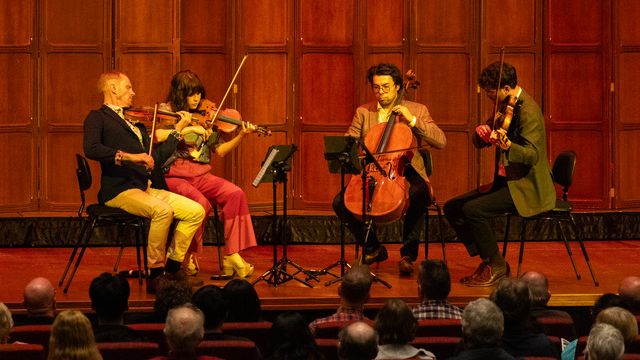Convergence
I have to admit to being a Benjamin Britten opera fanatic, have been since University. However, I was not as familiar with his string quartets, that is, until I attended Convergence at the Elder Hall, performed by the esteemed Australian String Quartet on the eve of their 40th birthday.
The Elder Hall is the quartet’s home, so it’s only fitting that they start their Australia wide tour in their home base. Abandoning the formal ‘blacks’ traditionally worn by musicians, the quartet Dale Barltop (violin), Francesca Hiew (violin), Chris Cartlidge (viola) and Michael Dahlenburg (cello) make chamber music accessible to all ages and many regions across our country.
 Their program has a bit of something for everyone – Paul Stanhope’s String Quartet No. 1, Elegies and Dances, Benjamin Britten’s String Quartet No. 2 and the epic Schubert String Quartet no 14, better known as Death and the Maiden.
Their program has a bit of something for everyone – Paul Stanhope’s String Quartet No. 1, Elegies and Dances, Benjamin Britten’s String Quartet No. 2 and the epic Schubert String Quartet no 14, better known as Death and the Maiden.
Paul Stanhope, an influential Australian composer and music educator, has a reputation for creating works that often reflect on human experience, memory, and cultural themes. His String Quartet No.1, Elegies and Dances is an important addition to contemporary chamber music, blending lyrical introspection with rhythmic vitality. The elegies can be seen as musical reflections on loss, remembrance, or tribute, while the dances celebrate life, movement, and vitality. The piece is rooted in tonalities but infused with contemporary dissonances.
It is an exquisite piece of quartet writing full on sonorous, ‘grieving’ passages from the violins, then ‘singing’ passages supported by pizzicato passages from the cello and viola. Stanhope has crafted each instrument’s voice, allowing individual lines to stand out within the collective sound. The ASQ clearly enjoy this piece as every detail of the score is captured, and the sound is glorious.
Benjamin Britten's String Quartet No. 2 Op. 36 was composed in 1945 and is an important work in his chamber music repertoire. Britten, a prominent British composer, wrote this piece during a period of intense creativity following World War II. He had visited a concentration camp and the horror of war can be heard clearly in this piece.
 Written in three movements – Allegro calmo senza rigore, Vivace and Chacony: Sostenuto it reflects Britten's mature style, blending traditional quartet forms with modern harmonic language and lyrical melodies, intricate counterpoint, and inventive tonal colours.
Written in three movements – Allegro calmo senza rigore, Vivace and Chacony: Sostenuto it reflects Britten's mature style, blending traditional quartet forms with modern harmonic language and lyrical melodies, intricate counterpoint, and inventive tonal colours.
The first movement is grounded on a ‘pedal note’ and flows gently along with ‘outbursts’ from all instruments. It is restless and relentless at times creating a sense of momentum. The quartet really sets the mood here for the rest of the composition.
The second movement features dramatic entries with recurrent themes over bass notes. The subtle shifts in tone and colour highlights Britten’s mastery of string writing beautifully rendered by the quartet.
The final movement is a theme-and-variations work that pays homage to Henry Purcell. After the theme is stated, there are twenty-one variations. It features stunning cello and viola solos (by Michael Dahlenburg and Chris Cartlidge) and is a race to the finish!
Franz Schubert's String Quartet No.14 in D minor, commonly known as Death and the Maiden, is one of his most famous and emotionally powerful works. Composed in 1824, when Schubert was just 27 years old and suffering from syphilis, the quartet is renowned for its lyrical depth, intense expressiveness, and mastery of chamber music.
 The nickname Death and the Maiden originates from the second movement's lyrical theme, which is based on Schubert's earlier song Der Tod und das Mädchen ("Death and the Maiden"). The movement's melody reflects themes of mortality, longing, and the human confrontation with death.
The nickname Death and the Maiden originates from the second movement's lyrical theme, which is based on Schubert's earlier song Der Tod und das Mädchen ("Death and the Maiden"). The movement's melody reflects themes of mortality, longing, and the human confrontation with death.
It is written in four movements – Allegro, Andante con moto, Scherzo: Allegro molto and Finale: Presto.
The first movement sets a sombre mood. It is passionate and tense characterised by dramatic contrasts and driving rhythms. The despair of this movement is beautifully highlighted by the quartet with its attention to dynamics.
The second movement features a haunting melody inspired by a song Schubert wrote based on a poem about death and longing. It features lyrical violin passages over pizzicato accompaniment by the cello, a vigorous tutti section and an impassioned last section. Dale Barltrop’s violin work in this movement is exceptional.
The third movement is a vigorous, restless scherzo that provides a stark contrast with its energetic motif. It’s energetic rhythm and playful character serve as a brief respite before the final movement.
The last movement is a variation on the theme from the original song Death and the Maiden. It begins with a haunting, slow theme, gradually building in intensity and ultimately transforming into a triumphant and defiant statement. It is a fast and furious race to the finish, with an amazing ending.

Death and the Maiden is a powerful piece and judging from the audience response the ‘hit’ of the evening and justly so, it is a credit to the talent and ability of the ASO.
Convergence is a night of chamber music excellence by Australia’s premier String Quartet! Happy 40th Birthday Australian String Quartet! May you have many more birthdays as you continue to bring quality chamber music to Australian audiences far and wide.
Barry Hill OAM
Photo credit Kane Moroney
Subscribe to our E-Newsletter, buy our latest print edition or find a Performing Arts book at Book Nook.

